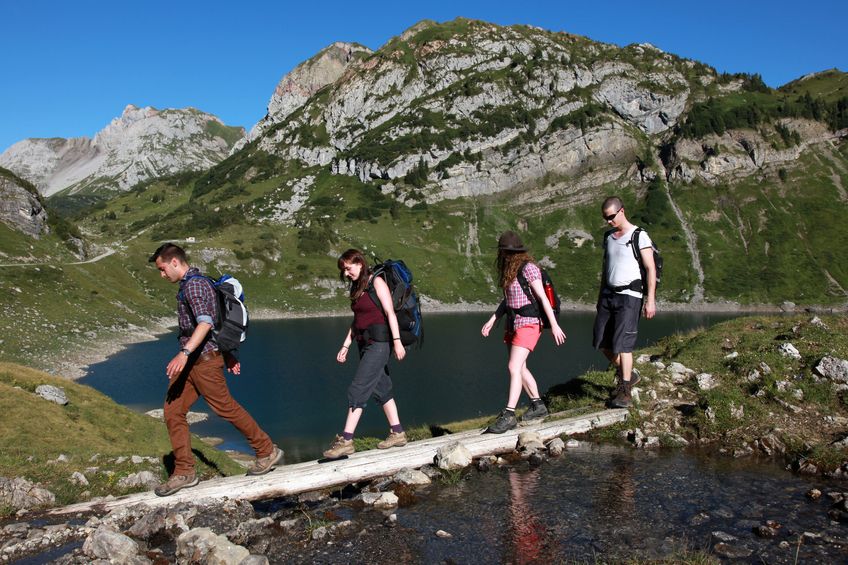Conditioning for Outdoor Activities
Prepare Now For Outdoor Activities
by ACE Physical Therapy and Sports Medicine Institute
Tips for Conditioning.
- Always spend time prior to your activity and warm up.
- You should begin all of your activities at a slow pace and pick it up as you feel less stiffness and warmer muscles. You might begin to sweat!
- Dynamic Stretching is better before competition.
- If you develop pain in a body part, put Ice on it and follow the RICE principles of acute injury treatment.
- Seek the advice of a Physical Therapist for a specific conditioning program.
Sunny days, warmer temperatures and clear blue skies call us outside to a variety of outdoor activities that include sports, gardening, hiking and more. Moving from an indoor, sedentary period to an active outdoor season requires a shift in body movements and cardiovascular demands. By preparing your body now for the full range of warm weather activities, you’ll be better equipped to fully enjoy the changing lifestyle and less likely to suffer injury.
Getting fit involves training the cardiovascular and musculoskeletal systems. Different body systems take varying amounts of time to “get in shape.” Depending on the level and intensity of participation, there is usually a strong correlation between the amount of time needed to perform the conditioning program and the frequency of sessions per week. By starting now, you can make sure that your whole body is ready to enjoy the full range of outdoor activities.
CARDIOVASCULAR EXERCISE:
The goal of a good routine in to maintain your heart rate at approximately 70% of the maximum heart rate for a minimum of 30 minutes 5 days per week. A simple formula to figure out your maximum heart rate is 220-your age x .70. (i.e. 220 – 52 = 168 x .70 = 117.6 or 118 beats per minute).
IDEAS:
Walking out-doors when appropriate
Jogging / running out-doors when appropriate
Treadmill walking or jogging
Elliptical trainer
Stairmaster
Speed walking in a Mall
Swimming
Jumping rope
Jogging in place
Walk the stairs
Dance
Roller skate
STRENGTH/ENDURANCE (muscular):
In most cases if you want to develop strength, you will perform 5-8 repetitions of the same exercise and perform it 5-7 times. If you can lift approximately 70-80% of your 1 repetition maximum in this manner, you will gain significant amount strength over time. You will have to continue to add resistance when the initial amount becomes too easy. A very simple and unscientific way of gauging your maximum is to lift the desired weight. If you “struggle” to complete the last 2 repetitions, but can maintain good form and have no pain you are close to the amount of weight/resistance that you will need to use to develop strength.
Endurance training is equally important especially in certain muscle groups (i.e. Para spinal musculature). The endurance of a muscle can be increased through lifting a lesser amount of weight/resistance at a greater number of repetitions. A good endurance program can consist of 3 sets of 15 repetitions of a weight/resistance that provides a challenge on the last 2-3 repetitions, but you can maintain good form and experience no pain.
The same exercises can be used for strength and endurance routines. All that must be adjusted is the amount of resistance and the number of repetitions. Performing these exercises 3 times per week is a great way to develop strength or endurance and you should not “train” on consecutive days.
IDEAS:
Push ups
Dips
Dumb bell flies and presses
Theraband pull a-aparts
Superman
Various Plank routines
Theraball core routine (see our previous blog on Low back exercises)
Squats (great for all activities sports to gardening)
Lunges
Gym workouts with free weights or machines
Swim
Yoga
Pilate’s
NOTE: If you plan to play a specific sport, you should incorporate specific strengthening exercise for that sport. Seek the advice from a Physical Therapist, and they can create a specialized conditioning program for you and your desired activity.
FLEXIBILITY:
Flexibility can be developed at any age and in almost anyone. It takes a lot of effort to gain range of motion and flexibility because the nature of the tissue that must “stretch” and elongate is more like “leather” than “rubber-bands.” There are two main types of stretching, Static and Dynamic.
Dynamic stretching is basically performing a movement similar to the movements of the activity in which you are preparing to participate. These Dynamic stretches are movements at a slow, controlled pace and the motions are exaggerated to move the joint(s) throughout their full range of motion.
Static stretching requires you to move the joint to a position where you feel a stretch and then stop and “hold” that position for a prolonged period of time. Static stretches are most effective post-exercise due to the increased tissue temperature. We recommend a minimum of 20 – 30 seconds. This type of stretch can never be held too long.
IDEAS:
Neck stretchs: side-to-side and angled towards the arm pit
Cross arm stretch: Clasp hands behind the back and attempt to touch the elbow together
Pull each elbow behind your head
Trunk rotational stretches
Knees to chest
Hamstring stretch
Quadriceps stretch
Calf stretch: Straight knee and slightly flexed knee
Yoga
Various stretching routines/classes
Partner stretching
NOTE: Some sports/activities require specific movements. These movements might place a great deal of stress on the soft tissue of a particular joint, therefore specific stretches for these areas need to be incorporated into the stretching routine. Seek the advice of a Physical Therapist who can direct you into performing the proper routine.
AGILITIES
If your activity requires you to start and stop your movements quickly, jump, sprint or twist and turn/change your direction of motion frequently, you should perform some type of exercise that will mimic motions and activities. The body must be prepared to handle these stresses and strains. Seek the advice of a Physical Therapist. Some general ideas are:
Carioca (grapevine) jogging and running
Defensive slides
Plyometrics
Jumping rope
Shuttle runs
Box run
Running backwards
As the days grow warmer and longer, we begin engaging in a variety of activities for the first time in several months. Without proper preparation, this can lead to sore muscles, joints and injuries to various parts of the body. Now is the time to begin proper conditioning, so that we will be prepared for the stresses and strains associated with “new” movements. These simple exercises can help us all avoid injuries that can “sideline” us from the activities that we love to perform.
Read more articles on our main website blog at: ACE-pt.org/blog
Vist our main website at www.ACE-pt.org


